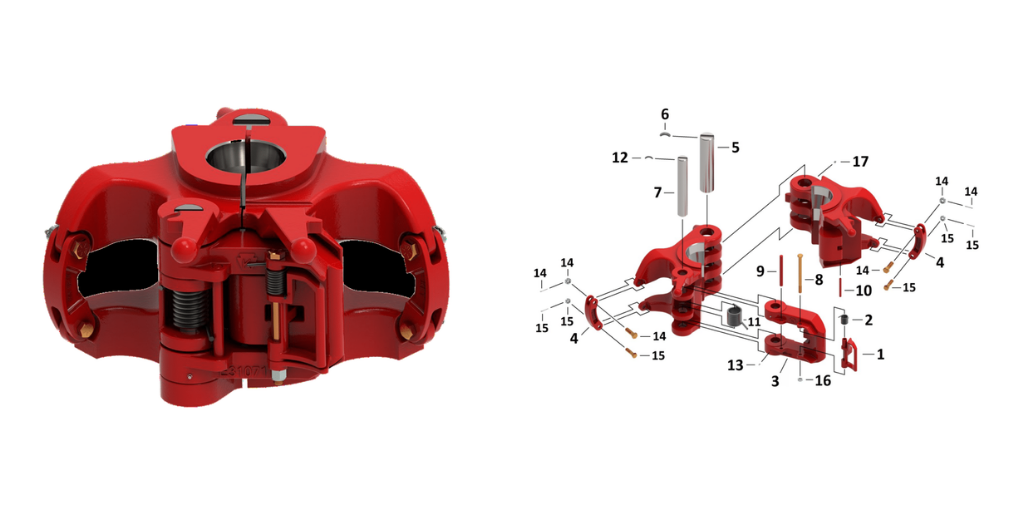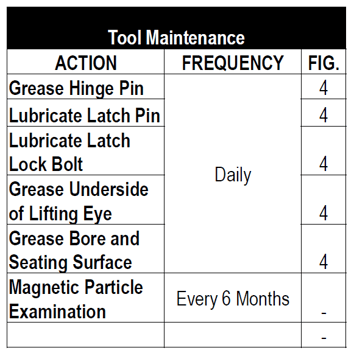 Elevators come in many different types—A series, G series, Y series and more. Since this is a product that we manufacture and know well, we wanted to explain to you what we feel is important for you to be thinking about before and after purchasing them. This article in particular will discuss G Series elevators also known as Bottleneck Elevators.
Elevators come in many different types—A series, G series, Y series and more. Since this is a product that we manufacture and know well, we wanted to explain to you what we feel is important for you to be thinking about before and after purchasing them. This article in particular will discuss G Series elevators also known as Bottleneck Elevators.
About Bottleneck G Series Elevators
Bottleneck, G Series elevators, are used for lifting and lowering piping, casing, and tubes. They are a kind of center latch elevator. They have an 18 degree taper shoulder. Due to their design, only tubes with an 18 degree external upset should be used. G series elevators can have a very high tonnage capacity, with some models reaching up to 700 tons.
API Certified Equipment
To ensure that you are receiving a quality elevator it is highly recommended that you only buy API certified equipment. The American Petroleum Institute (API) licenses “Drilling and Production Hoisting Equipment” manufacturers under API Spec 8C, which covers elevator links, tubing and drill pipe elevators, sucker rod elevators, spiders (if capable of being used as elevators) and various other types of handling tools.
API is a globally recognized certification and licensing leader in various industries, and also has extensive experience licensing and certifying regular elevators as well. Any manufacturer with the API seal of approval is compliant with API standards and has the proven capability to manufacture to API Product Specification Requirements.
Purchasing equipment from a supplier with API Certification ensures you are buying quality equipment that meets API industry standards.
Routine Inspection Of Bottleneck G Series Elevators
Of all the tools on a drilling rig, elevators are one of the most stressed pieces of equipment. Due to this, they require regular inspection. They should be visually examined, at minimum, on a weekly basis for cracks, dents, loose couplings or other signs of wear and tear. Upon noticing damage, no longer suitable components should be swapped out immediately with replacement parts which are recommended to be kept on site as a preventative measure.
..
Of all the tools on a drilling rig, elevators are one of the most stressed pieces of equipment. Due to this, they require regular inspection. KET's operation manual lays out the necessary inspections that must be performed for optimum performance.
There are 2 types of inspections the MRA and TMA Operating manual advise--daily inspections and inspections every 6 months.
Proper Elevator Inspection
- Visually inspects for cracks, loose fits or connections, and other signs of wear, corrosion or overloading.
- Check for loose or missing components, deterioration, proper lubrication, and adjustment.
- Check for worn hinge pin, latch pin and latch lock pin. These may inhibit proper closing of the door and latch lock engagement.
- Check for proper operation of Latch Stop mechanism. The Latch should not stop against the door when closed but have no more than ¼” of standoff from the door.
- Check springs for damage, deformation and lack of tension.
- Check link block bolts for nuts and cotter pins.
- Lubricate the elevator regularly during usage and storage to prevent corrosion. Use an extreme pressure, multi-purpose, lithium base grease of No. 1 or No. 2 consistency or a lubricant that meets MIL-SPEC-A907E.
**When greasing of pins make sure to pump grease until it comes out of both ends.**
Periodic Actions/Examinations Chart
We recommend to maintain the elevator as prescribed below in the periodic Actions/Examinations chart.
6 Month Inspections
Every 6 months a full NDT (Non-Destructive Testing) inspection of all primary-load carrying components should be performed as defined by the manufacture, in addition to the daily checks specified above.
Replacement Parts
Only KET manufactured parts should be used on KET Elevators.
Upon noticing damaged parts, you should contact Keystone to talk with a sales rep. to discuss and order the proper parts.
It is important to remember that a simple routine visual inspection can end up saving your rig hundreds of thousands of dollars throughout its lifetime, and most importantly help you to keep your team safe.
Keystone’s Bottleneck G Series Elevators
Our Bottleneck G Type elevators are manufactured in the USA and are API certified, They are designed for drill pipe with an 18 deg. taper, and are available in five types: “MG” 100-ton, “RG” 150-ton, “MGG” 250-ton, and “GG” 350-ton, and “HGG” 500-ton.
They cover pipe sizes from 2 3/8” – 5 7/8”. The “MGG” and “GG” models can be fitted with a special wear bushing in the bottom to help reduce bore wear when used with Top Drive systems.
MG Elevator
| Part No | Range | Size of Links | Weight |
|---|---|---|---|
| E30157 | 2 3/8″ – 5″ | 1- 3/4″ – 2 -3/4″ | 240.00 |
RG Elevator
| Part No | Range | Size of Links | Weight |
|---|---|---|---|
| E30155 | 2 3/8″ – 4 1/2″ | 1- 3/4″ – 2 -3/4″ | 350.00 |
MGG Elevator
| Part No | Range | Size of Links | Weight |
|---|---|---|---|
| E35005 | 3 1/2″ – 5 1/2″ | 2 1/4″ – 3 1/2″ | 600.00 |
MGG IB Elevator
| Part No | Range | Size of Links | Weight |
|---|---|---|---|
| E35005-IB | 2 7/8″ – 5″ | 2 1/4″ – 3 1/2″ | 600.00 |
GG Elevator
| Part No | Range | Size of Links | Weight |
|---|---|---|---|
| E31068 | 3 1/2″ – 6 5/8″ | 2 1/4″ – 3 1/2″ | 700.00 |
GG IB Elevator
| Part No | Range | Size of Links | Weight |
|---|---|---|---|
| E35005-IB (MGG) | 2-7/8″-5″ | 2-1/4″-3-1/2″ | 600.00 |
| E31068-IB (GG) | 2 7/8″ – 5″ | 2 1/4″ – 3 1/2″ | 750.00 |
| E31068-IB-2 (GG) | 2-7/8″-5 1/2″ | 2-1/4″-3-1/2″ | 800.00 |
KET HGG (500 TON) BOTTLENECK ELEVATOR
| Part No | Range | Size of Links | Weight |
|---|---|---|---|
| E70013 | 4″-6-5/8″ | 2-1/4″-3-1/2″ | 1,220 |
Keystone’s Drilling Elevators
KET is a leading manufacturer of Drill Pipe Elevators. We design and precision-machine all of our elevators to meet and exceed API Standards, with KET and the API monogram stamped on our equipment, you can be sure you are getting high-grade equipment at a competitive price, made in the USA.
KET’s full elevator line includes
- Square Shoulder Elevators
- Slip Type Elevators
- Slim Hole Slips For Slip Type Elevators
- Side Door Elevators
- Single Joint Elevators
Want to learn more about Keystone's G Series Bottleneck Elevators or Replacement Parts?
About Keystone Energy Tools
Keystone Energy Tools is a manufacturer with over fifty years of combined experience in designing, manufacturing, and delivering high-quality oilfield tools, including elevators, slips, dies and inserts, tongs dies, safety clamps, stabbing guides, drill pipe float valves, baffle plates, float valve pullers, rotating mouseholes, and tong blocks.
By using the latest in 3D modeling for product design and by staying current with the rapid advances in manufacturing technology and quality-assurance standards, Keystone is able to manufacture and produce the most reliable products on the market today.




